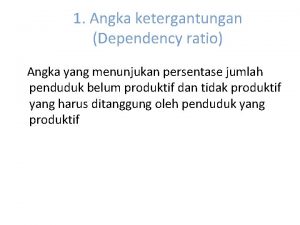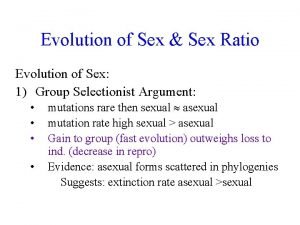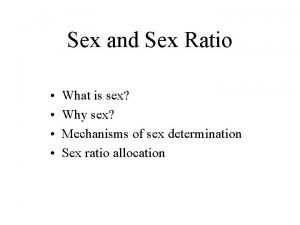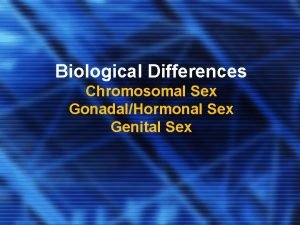Chapter 9 Sex allocationratio distorters Sex ratio distorters


















- Slides: 18

Chapter 9 Sex allocation/(ratio) distorters

Sex ratio distorters • The ESS SR may differ between the point of view of different genes within an individual conflict over SR • SR distorting elements: – Nuclear genes – Cytoplasmatic elements

Nuclear genes Sex chromosome meiotic drive: 1. Y chromosome drive leads to male bias: Y chromosome only transmitted by males so a gene on Y that will lead to more male offspring will spread 2. X chromosome drive leads to female bias: X drive at the cost of Y Spread slower Commonly found in Diptera More common than Y drive Aedes aegypti

B chromosomes • Supernumerary chromosome, not required for fitness • Generally no effect on SR but: – PSR in Nasonia vitripennis, only male offspring produced – Ultimate selfish element, ensures own transmission at cost of the rest of the genome

Cytoplasmic genes • Only transmitted trough the maternal line > selection for SR distortion • Include mitochondria and micro-organisms (Wolbachia, cardinium) • Several mechanism found to increase the amount of female offspring produced

Feminizers • Override the nuclear sex determination • Found in woodlice, mites, parasitoids and shrimp • Frequency often lower than expected, might be caused by risk of producing intersexes

Maternal Sex Ratio • Influences the fertilization rate • Found in some parasitoids • Should rapidly spread to fixation ? ?

Male killers • Two types: early and late – Early: resources allocated to sons can be used by daughters with related bacteria – Late: males used as vectors for horizontal transfer

Parthenogenesis induction • In haplodiploids: unfertilized eggs develop into females • Genome duplication • Found in several insect taxa

Cytoplasmic incompatibility • Not strictly SR distorter /only males • In haploids male unaffected >leads to male biased SR

Genomic imprinting • Differential expression alleles dependent on parental origin • Alleles from different backgrounds can disagree over SR • Imprinting as a battle ground for conflict over SR

Spread of SR distorters • Often not fixed in populations • Possible explanation: – Balancing selection • Reduced fertility/survival infected individuals • Sexual selection, avoiding infected individuals – Suppressors • Sex chromosome linked • Autosomal: Fisherian selection

PSR • Spread dependent on fertilization rate • It can only invade when FR > 0. 5 –LMC causes female biased SR, but small patch size selects against PSR –Presence of MSR, although PSR selects against MSR

Male killing • Spread dependent on transmission rate – High transmission: fixation, population extinction – Low transmission: intermediate frequency • • Resource reallocation among offspring Survival cost Mating preference Selection for nuclear suppression because of – Increase in fecundity – Fisherian advantage of rare sex

The consequences of SR distorters 1. Compensatory SR adjustment Only under imperfect transmission Under high transmission, no selection >no gene flow between infected and uninfected part population

Other effects of SR distorters • Sex role reversal, due to biased SR • The evolution of new sex determination systems e. g haplodiploidy • Adjustment of breeding system e. g. larger clutches, multiple mating, reallocation of resources among offspring • Selective sweep, hitchhiking effect, reduced recombination (X drive)

Conclusion • Main topics for future research: – What controls variation across taxa – The interplay between different distorters – Consequences for host biology Lots of theory, but need for empirical data

Final thoughts • Why so often in haplodiploids? • Mechanisms: how does the drive work, details of mechanisms might influence effects
 Kurt bumby
Kurt bumby Sex sex sex
Sex sex sex Xxtesticles
Xxtesticles Sex sex sex
Sex sex sex Sex sex sex
Sex sex sex X linked recessive punnett square
X linked recessive punnett square Sex determination in drosophilla
Sex determination in drosophilla Sex determination and sex linkage
Sex determination and sex linkage Once a sex offender always a sex offender
Once a sex offender always a sex offender Cara menghitung cumulative incidence
Cara menghitung cumulative incidence Single age
Single age Teori kependudukan arsene dumont
Teori kependudukan arsene dumont Youth dependency ratio ap human geography
Youth dependency ratio ap human geography Rumus sex ratio
Rumus sex ratio Rumus angka ketergantungan
Rumus angka ketergantungan Sex ratio
Sex ratio Sex ratio in odisha
Sex ratio in odisha Sex ratio aphg
Sex ratio aphg Hazard ratio vs odds ratio
Hazard ratio vs odds ratio

































